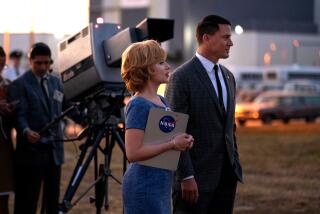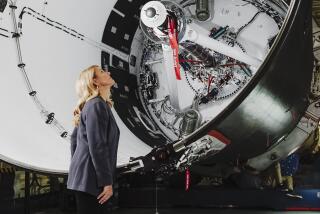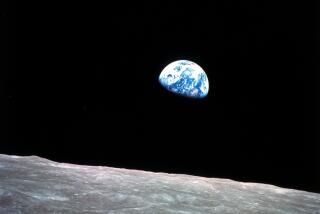Rocketdyne Looks Back 30 Years to Apollo’s Lunar Mission
- Share via
Peter Schilhavy was just 11 years old when astronaut Neil Armstrong stepped onto the desolate gray surface of the moon.
Despite being at an age when collecting baseball cards and riding bikes were pretty much full-time occupations, the event filled him with awe and inspiration.
And it still does.
“It really is amazing,” said Schilhavy, a system design engineer who works at Rocketdyne’s Santa Susana Field Laboratory near Chatsworth--the same place where the engines used in the Apollo program were designed and tested. “Being able to look at this stuff and to work with the same men who put it all together is probably the most any engineer could want.”
On Wednesday, in a parking lot not far from the old engine test sites, the company hosted a 30-year commemorative retrospective of its role in helping etch the surface of the moon with the footprints of man.
The event was reserved for employees of Boeing Co.’s Rocketdyne Division, dozens of whom gazed at the old rocket engines and components and spoke with people such as Arnold Sodergren, who supervised engine testing for the company during the 1960s.
In the decade leading up to the July 20, 1969, moon landing, Rocketdyne’s mountaintop facility was a hive of activity, packed with engineers designing, testing and producing the six types of engines used in the Apollo program.
More than 6,000 people worked at the site during the 1960s, with shifts beginning every 12 minutes, 24 hours a day, seven days a week.
“Lots of cigarettes and coffee went into the moon landing,” joked Jim Lang, who worked in the company’s now-defunct nuclear program during the Apollo engine testing. “You could tell something really important was going on here.”
It may be difficult for those who were not directly involved in the Apollo program to fully grasp the achievement of Armstrong’s “one small step.”
The challenge of catapulting three men from the surface of the Earth, hurtling them through space to orbit another celestial body, landing them there and bringing them back alive is almost too much to describe, those who were involved say.
*
Technically, the endeavor bordered on science fiction. Lives and national pride were at stake. And there was a strict deadline, imposed by President Kennedy, to land a man on the moon--there were no women astronauts then--and return him safely to Earth by the end of the decade.
At the time, Cold War rhetoric had reached its peak.
Soviet Premier Nikita Khrushchev had admonished the United States in his famous shoe-pounding speech at the United Nations, saying “we will bury you.”
The Soviet Union was also edging out the Americans in the space race, having already launched the first satellite and man into orbit. And the Soviet Union was well on its way toward landing a man on the moon, having designed and tested a rocket more massive than the Apollo program’s towering Saturn V.
“There was a feeling then that we couldn’t let [them] win,” Sodergren said. “We were all very aware of that and everything we did we did to get there first. . . . Luckily it worked.”
Sodergren, who still works at Rocketdyne as a technical advisor, continues to be amazed by what he and the thousands of others who worked on the Apollo program were able to accomplish.
He remembers the day Armstrong opened the hatch to the lunar module, stepped down the ladder and onto the surface of the moon.
While the world erupted in a chorus of cheers, he took a deep breath.
It was a relief, he said, to see everything up to that point had gone as planned.
“I remember all the emotions and feelings I had,” said Sodergren, now 62. “When you consider the magnitude of the project and that all those millions of parts worked together, it was unbelievable. . . . It’s still unbelievable.”
Although at the time he felt a keen sense of pride at besting the Soviet Union and putting his country at the forefront of space exploration, 30 years has given him some perspective.
*
Playing a part in humanity’s greatest adventure and grandest feat is what is most important, not coming in first, he said.
Today, the engineers who motor up the winding mountain road to the lab keep busy designing and testing rocket engines, but there isn’t the feeling they are working toward such a momentous goal.
The engines that people such as Schilhavy and Sodergren now work on will, for the most part, boost commercial satellites and space probes into orbit.
Yet knowing they are part of a legacy that for a few years illustrated humankind’s greatest attributes is something they don’t take for granted.
“I’m still amazed by all of this,” said Schilhavy, as he looked up toward one of the big J-2 booster engines. “It still inspires me.”
More to Read
Sign up for Essential California
The most important California stories and recommendations in your inbox every morning.
You may occasionally receive promotional content from the Los Angeles Times.










